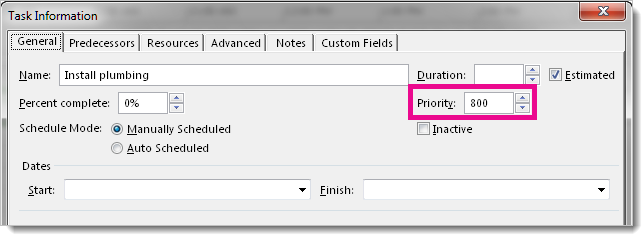Set task priorities for resource leveling
Manually balancing the workload of people can be a cumbersome task for any project manager. Fortunately, Project's resource leveling feature can help you by automatically delaying or splitting tasks so the resources assigned to them are no longer overallocated. You control which tasks can be leveled by setting priorities for them. Learn more.
These instructions are specific to Microsoft Project 2016, 2013, and 2010.
Set the task priorities
-
On the Gantt Chart, double-click the name of the task to bring up the Task Information box.
-
On the General tab, in the Priority box, enter a number between 1 and 1,000. Tasks with a lower priority are delayed before those with a higher priority.
If you don't want Project to level a task, such as a task that must start on a specific date, set its priority level to 1000. By default, priority values are set at 500, or a medium level of control.
Project management tip Using the Task Information box to set priorities on multiple tasks can quickly become tedious. Use a sheet column instead. Right click on a column heading, click Insert Column, and click Priority.
An example
The task called "install plumbing" has a priority of 800. This means that Project could move it during leveling as the priority is lower than 1000. If it is more important to the schedule that this task not be moved over other tasks, raise the priority to 1000. At 1000, , Project would not move this task when resources are leveled.

These instructions are specific to Microsoft Project 2007.
Set the task priorities
-
On the View menu, click Gantt Chart.
-
In the Task Name field, select the task whose priority you want to change, and then click Task Information
 .
. -
Click the General tab, and then type or select a priority in the Priority box.
Set the project priorities
-
On the Project menu, click Project Information.
-
Type or select a priority in the Priority box.
Distribute the project work by leveling
-
On the Tools menu, click Level Resources.
-
Under Leveling calculations, click Automatic or Manual.
Manual leveling (the default) occurs only when you click Level Now. Automatic leveling occurs instantaneously whenever you change a task or resource. Use automatic leveling if you want to reschedule tasks whenever resources are assigned more work than they have the capacity to complete.
-
If you choose automatic leveling, clear the Clear leveling values before leveling check box. When this check box is cleared, Project levels only new and unleveled assignments. This check box is selected by default, but when leveling automatically, leaving it selected can significantly slow down your work in the schedule because all tasks are leveled. In the Look for overallocations on a box, click a time period, or basis, for the sensitivity with which leveling will recognize overallocations. Day by Day is the default. This setting establishes the point at which you want leveling to intervene: when you have an overallocation within just one minute, one day, one week, or one month.
-
Under Leveling range for, select to level the entire project or to level only those tasks falling within a specific time range.
-
In the Leveling order box, select the leveling order that you want:
-
Select ID Only to level tasks in ascending order of their ID numbers before considering any other criteria.
-
Select Standard to first examine predecessor dependencies, slack, dates, priorities, and constraints to discover whether and how tasks should be leveled. (This is the default setting.)
-
Select Priority, Standard to check task priorities first and only then examine the standard criteria.
-
-
To prevent the finish date of your project from being delayed, select the Level only within available slack check box.
Note: If you select this check box, you may get error messages indicating that Project can't level the entire schedule. Project may not level the schedule because there is seldom enough slack in a schedule to reschedule assignments without running out of slack time.
-
To allow leveling to adjust when a resource works on a task independently of other resources that are working on the same task, select the Leveling can adjust individual assignments on a task check box.
-
If you want leveling to interrupt tasks by creating splits in the remaining work on tasks or resource assignments, select the Leveling can create splits in remaining work check box. If a resource is assigned to tasks concurrently beyond what the resource's schedule can handle, then a task that has remaining work can be split and worked on when the resource's schedule will allow it.
-
To include proposed resources, select the Level tasks with the proposed booking type check box.
-
If you want to clear the previous leveling results before leveling again, then click Clear Leveling.
-
If you are leveling manually, then click Level Now. If you are leveling automatically, click OK.
The Level Now dialog box appears if a resource view that has selected resources was showing when you opened the Resource Leveling dialog box. Click Selected resources if you want to level only the selected resources. Otherwise, click Entire pool.
-
To clear leveling immediately before doing any other action, click Undo Level. If you don't undo the leveling, you can also click Clear Leveling to clear the previous leveling results.
-
If you level tasks in projects that are scheduled from a finish date, then negative delay values are applied from the end of the task or assignment, causing the task or resource assignment's finish date to occur earlier.
-
To see the changes made to tasks by leveling, on the View menu, click More Views, click Leveling Gantt, and then click Apply.
No comments:
Post a Comment